The AMD A8-7650K APU Review, Also New Testing Methodology
by Ian Cutress on May 12, 2015 10:00 AM ESTOffice Performance
The dynamics of CPU Turbo modes, both Intel and AMD, can cause concern during environments with a variable threaded workload. There is also an added issue of the motherboard remaining consistent, depending on how the motherboard manufacturer wants to add in their own boosting technologies over the ones that Intel would prefer they used. In order to remain consistent, we implement an OS-level unique high performance mode on all the CPUs we test which should override any motherboard manufacturer performance mode.
All of our benchmark results can also be found in our benchmark engine, Bench.
Dolphin Benchmark: link
Many emulators are often bound by single thread CPU performance, and general reports tended to suggest that Haswell provided a significant boost to emulator performance. This benchmark runs a Wii program that raytraces a complex 3D scene inside the Dolphin Wii emulator. Performance on this benchmark is a good proxy of the speed of Dolphin CPU emulation, which is an intensive single core task using most aspects of a CPU. Results are given in minutes, where the Wii itself scores 17.53 minutes.
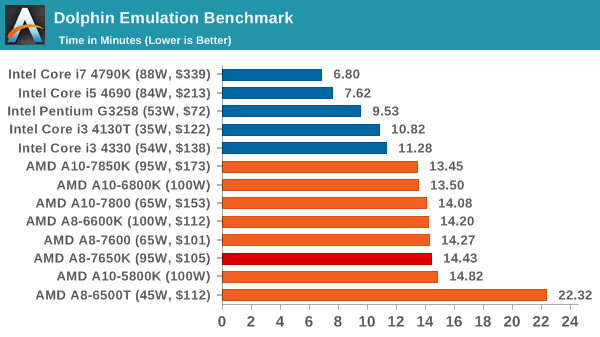
Dolphin likes high IPC and clock frequency, which indicates that the highest clocked APUs perform the best out of AMD here. Because the benchmark is single threaded, even a dual core Intel wins though.
WinRAR 5.0.1: link
Our WinRAR test from 2013 is updated to the latest version of WinRAR at the start of 2014. We compress a set of 2867 files across 320 folders totaling 1.52 GB in size – 95% of these files are small typical website files, and the rest (90% of the size) are small 30 second 720p videos.

The varied-thread workload of WinRAR seems to vary between the dual core Intels and the dual module AMD chips, showing that threads matter.
3D Particle Movement
3DPM is a self-penned benchmark, taking basic 3D movement algorithms used in Brownian Motion simulations and testing them for speed. High floating point performance, MHz and IPC wins in the single thread version, whereas the multithread version has to handle the threads and loves more cores.

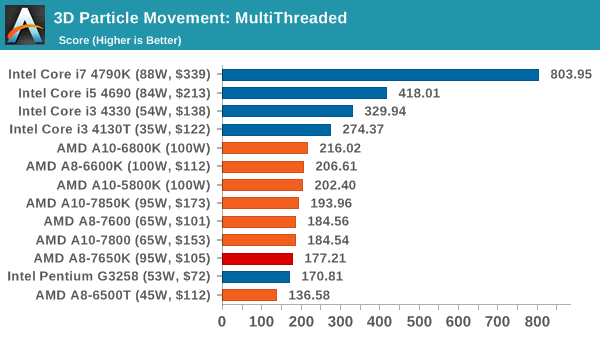
In this nieve benchmark, the compiler prefers x87 style commands which AMD's Bulldozer based architectures isn't too fond of. This benchmark is meant to be a representation of crude scientific code, similar to that used in a research lab. Ultimately, Bulldozer architectures such as Kaveri prefer specific commands, especially when dealing with basic math.
FastStone Image Viewer 4.9
FastStone is the program I use to perform quick or bulk actions on images, such as resizing, adjusting for color and cropping. In our test we take a series of 170 images in various sizes and formats and convert them all into 640x480 .gif files, maintaining the aspect ratio. FastStone does not use multithreading for this test, and results are given in seconds.
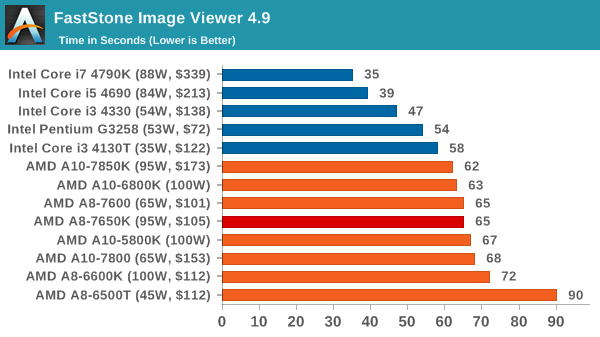
Web Benchmarks
On the lower end processors, general usability is a big factor of experience, especially as we move into the HTML5 era of web browsing. For our web benchmarks, we take four well known tests with Chrome 35 as a consistent browser.
Sunspider 1.0.2

Mozilla Kraken 1.1

WebXPRT
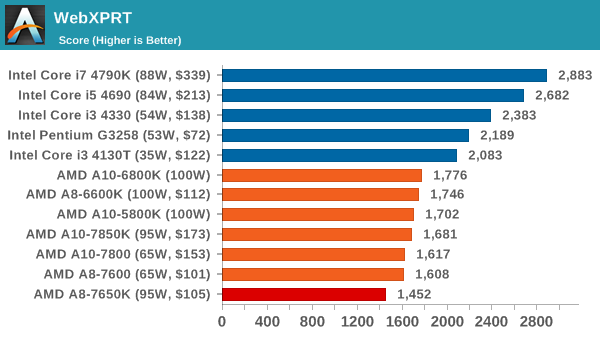
Google Octane v2
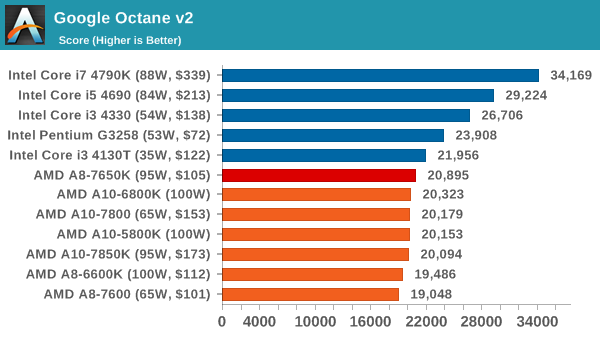










177 Comments
View All Comments
jabber - Tuesday, May 12, 2015 - link
Exactly."Yayyyy I use 7Zip all day long! "
Said no one...ever.
I don't even know why people still compact files? Are they still using floppies? Man, poor devils.
Gigaplex - Tuesday, May 12, 2015 - link
I've been getting BSODs lately due to a bad Windows Update. The Microsoftie asked me to upload a complete memory crash dump. There's no way I can upload a 16GB dump file in a reasonable timeframe on a ~800kbps upload connection, especially when my machine BSODs every 24 hours. Compression brought that down to a much more manageable 4GB.galta - Tuesday, May 12, 2015 - link
So it makes perfect sense for yoy to stay with AMD...NeatOman - Wednesday, May 13, 2015 - link
I use it everyday :( rocking a FX-8320@4.5Ghz for the last 3 years.. I picked it up for $180 with the CPU and!! Motherboard. I was about to pick up a 3770k too, saved about $200 but am about 15-20% down on performance. And if you're worried about electrical cost, you're walking over dollars to pick up pennies.I do it to send pictures of work I do, and a good SSD is key :)
UtilityMax - Tuesday, May 12, 2015 - link
If you look at the WinRAR benchmark, then that result strongly suggests that WinRAR is multi-threaded. I mean, two core two thread Pentium is clearly slower than the two core but four thread Core i3, and quad-core i5 is clearly faster than Core i3, and Core i7 with its eight threads is clearly faster than Core i5. Hence galta's comment that AMD FX with 8 cores is probably even faster, but he says that this is not normal usage.TheJian - Thursday, May 14, 2015 - link
There is an actual checkbox in winrar for multithreading for ages now. ROFL. 95% of usenet uses winrar, as does most of the web. That doesn't mean I don't have 7zip installed, just saying it is only installed for the once in 6 months I find a file that uses it.You apparently didn't even read what he said. He clearly states he's using winrar and finds FX is much faster using 8 cores of FX in winrar. You're like, wrong on all fronts. He's using winrar (can't read?), he's using FX (why suggest it? Can't read?) AND there is a freaking check-box to turn on multi-threading in the app. Not sure whether you're shilling for AMD here or 7zip, but...jeez.
galta - Saturday, May 16, 2015 - link
Last AMD CPU I had was the old and venerable 386DX@40Mhz. Where any of you alive back in the early 90s?Ever since I've been using Intel.
Of course there were some brief moments during this time when AMD had the upper hand, but the last it happened was some 10 years ago when Athlom and its two cores were a revolution and smashed Pentium Ds. It's just that during that particular moment I wasn't looking for an upgrade so I've Intel ever since.
Having said that, I have to add that I don't understand why we are spending so much time discussing compression of files.
Of course that the more cores you have the better, and AMD happens to have the least expensive 8 core processor on the market, BUT most users spend something like 0.15% of their time compressing files, making this particular shinny performance irrelevant for most of us.
Because most of other software does not scale so good in multithreading (and for games, it has nothing to do with DX12 as someone said elsewhere), we are most likely interested in performance per core, and Intel clearly has the lead here.
NeatOman - Wednesday, May 13, 2015 - link
Truth is the average user won't be able to tell the difference on a system with a i3 running on a ssd and a A6-7400k on a ssd or even a A10-7850k which would be more direct competition to the i3. I build about 2-4 new Intel and AMD systems a month and the only time I myself notice is when I'm setting them up, after that they all feel relitivly close in speed due to the SSD which was the largest bottleneck to have been overcome in the last 10 years.So Intel might feel snappier but are still not much faster in day to day use of heavy browsing and media consumtion as long as you have enough ram and a decent SSD.
mapesdhs - Tuesday, May 12, 2015 - link
Ian Cutress wrote:> Being a scaling benchmark, C-Ray prefers threads and seems more designed for Intel."
It was never specifically designed for Intel. John told me it was, "...an extremely
small program I did one day to figure out how would the simplest raytracer program
look like in the least amount of code lines."
The default simple scene doesn't make use of any main RAM at all (some systems
could hold it entirely in L1 cache). The larger test is more useful, but it's still wise to
bare in mind to what extent the test is applicable to general performance comparisons.
John confirmed this, saying, "This thing only measures 'floating point CPU performance'
and nothing more, and it's good that nothing else affects the results. A real rendering
program/scene would be still CPU-limited meaning that by far the major part of the time
spent would be CPU time in the fpu, but it would have more overhead for disk I/O, shader
parsing, more strain for the memory bandwidth, and various other things. So it's a good
approximation being a renderer itself, but it's definitely not representative."
As a benchmark though, c-ray's scalability is incredibly useful, in theory only limited by
the no. of lines in an image, so testing a system with dozens of CPUs is easy.
Thanks for using the correct link btw! 8)
Ian.
PS. Ian, which c-ray test file/image are you using, and with what settings? ie. how many
threads? Just wondered if it's one of the stated tests on my page, or one of those defined
by Phoronix. The Phoronix page says they use 16 threads per core, 8x AA and 1600x1200
output, but not which test file is used (scene or sphfract; probably the latter I expect, as
'scene's incredibly simple).
Ian Cutress - Tuesday, May 12, 2015 - link
It's the c-ray hard test on Linux-Bench, usingcat sphfract | ./c-ray-mt -t $threads -s 3840x2160 -r 8 > foo.ppm
I guess saying it preferred Intel is a little harsh. Many programs are just written the way people understand how to code, and it ends up sheer luck if they're better on one platform by default than the other, such as with 3DPM.